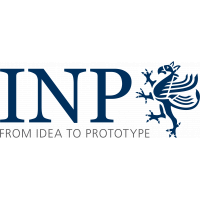The lifetime of tungsten cathodes used in plasma spray torches is limited by processes leading to a loss of cathode material. It was reported in the literature that the mechanism of their erosion is the evaporation. A model of the ionization layer of a cathode is developed to study the diffusive transport of evaporated tungsten atoms and tungsten ions produced due to ionization by electron impact in a background argon plasma. It is shown that the Stefan-Maxwell equations do not reduce to Fick law as one could expect for the transport of diluted species, which is due to significant diffusion velocities of argon ions. The ionization of tungsten atoms occurs in a distance of a few micrometers from the cathode surface and leads to a strong sink, which increases the net flux of tungsten atoms far beyond that obtained in absence of tungsten ions. This shows that the tungsten ions are driven by the electric field towards the cathode resulting in no net diffusive flux and no removal of tungsten species from the ionization layer even if convection is accounted for. A possible mechanism of removal is found by extending the model to comprise an anode. The extended model resolves the inter-electrode region and provides the plasma parameters for a current density corresponding to the value at the center of the cathode under typical arc currents of 600 A and 800 A. The presence of the anode causes a reversal of the electric field on the anode side, which pulls the ions away from the ionization layer of the cathode. The net flux of tungsten ions can be further fortified by convection. This model allows one to evaluate the loss of cathode material under realistic operating conditions in a quantitative agreement with measured values.
| Field | Value |
|---|---|
| Group | |
| Authors | |
| Release Date | 2022-07-07 |
| Identifier | f7116dbe-455b-451d-b7d7-8a8a48d82993 |
| Permanent Identifier (DOI) | |
| Permanent Identifier (URI) | |
| Is supplementing | |
| Plasma Source Name | |
| Plasma Source Application | |
| Plasma Source Specification | |
| Plasma Source Properties | The torch is typically operated in pure argon, and mixtures of argon with hydrogen or nitrogen with flow rates between 40 and 80 NLPM and direct electric current of several hundred amperes. |
| Plasma Medium Name | |
| Plasma Medium Properties | Thermal plasma in the arc column, non-equilibrium plasma near the electrodes. |
| Plasma Target Name | |
| Plasma Target Properties | Tungsten can withstand temperatures up to about 3800 K. It is used to provide thermionic emission of electrons. |
| Plasma Target Procedure | Due to the erosion, the cathode has to be replaced by a fresh one. The lifetime of the cathode depends also on the operating conditions. |
| Plasma Diagnostics Name | |
| Plasma Diagnostics Procedure | The erosion of the cathode made of lanthanated tungsten is studied by two models considering the diffusive transport of evaporated atoms from the cathode. |
| Language | English |
| License | |
| Public Access Level | Public |
| Contact Name | Margarita Baeva |
| Contact Email |
Data and Resources
- Modelling and experimental evidence of the cathode erosion - Figure 5csv
The values of the temperature T_c (a), the current density j (b), and the...
Preview Download - Modelling and experimental evidence of the cathode erosion - Figure 6csv
Number densities of neutral and charged species in the ionization layer of...
Preview Download - Modelling and experimental evidence of the cathode erosion - Figure 7csv
The ionization length for an argon plasma at atmospheric pressure is...
Preview Download - Modelling and experimental evidence of the cathode erosion - Figure 8csv
Number densities of tungsten atoms n_wa are computed without (curves 1-3)...
Preview Download - Modelling and experimental evidence of the cathode erosion - Figure 9csv
The density of net fluxes J_wa of tungsten atoms are obtained with input...
Preview Download - Modelling and experimental evidence of the cathode erosion - Figure 10csv
Parameters of the microarc plasma in atmospheric pressure argon are computed...
Preview Download - Modelling and experimental evidence of the cathode erosion - Figure 11csv
Number densities of tungsten atoms and ions at a current density of 10^8 A/m...
Preview Download - Modelling and experimental evidence of the cathode erosion - Figure 12csv
The effect of the convection on the electric field (a), the diffusive...
Preview Download

![[Open Data]](https://assets.okfn.org/images/ok_buttons/od_80x15_blue.png)